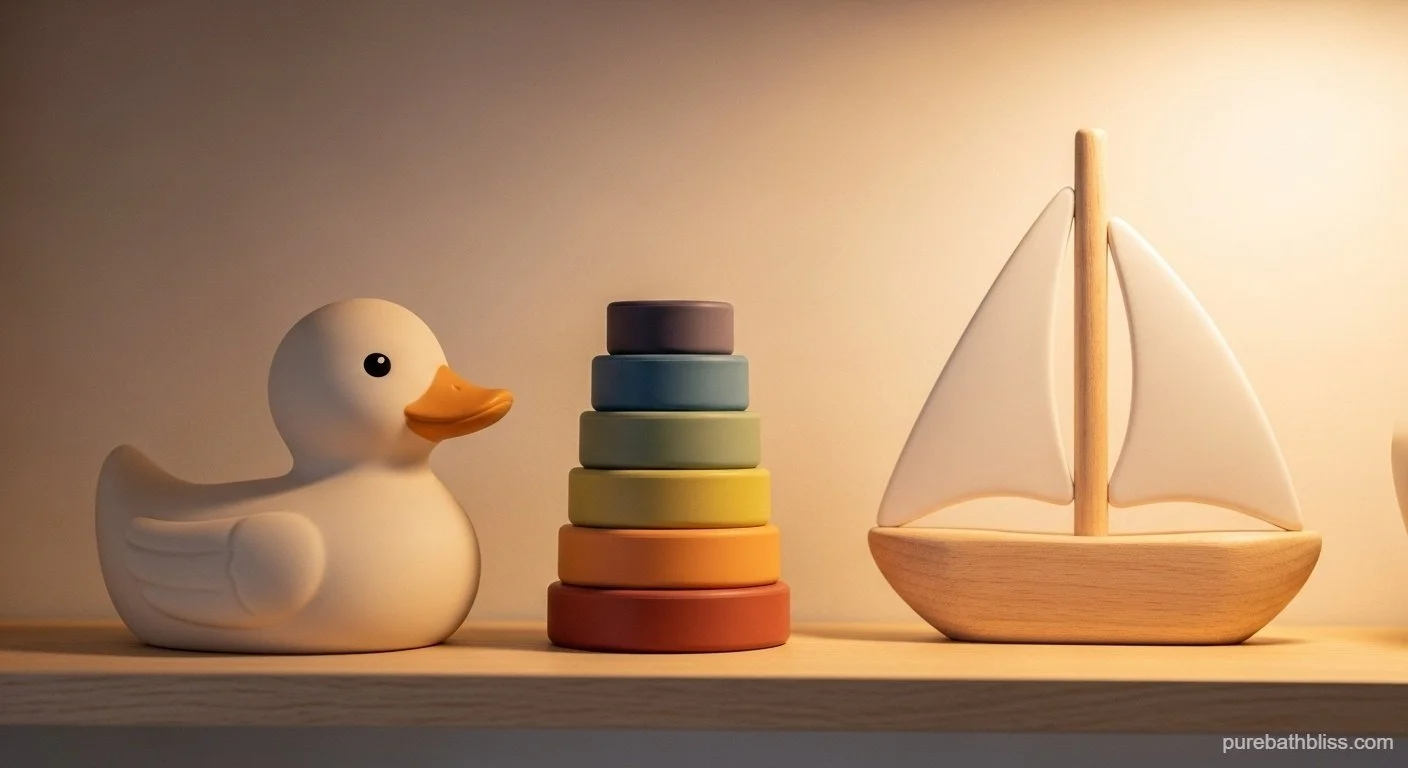The Hidden Danger in the Rubber Duck: A Parent’s Guide to Mold-Free & Non-Toxic Bath Toys
You’ve seen the photos. A parent slices open a cute yellow rubber duck after months of daily baths. Inside: thick, black slime coating the walls. That toy has been sprayed directly into your baby’s mouth dozens of times.
You’re not overreacting. You’re right to be horrified.
The classic rubber duck—and almost every squirty animal sold in big-box stores—is one of the dirtiest, most chemical-laden objects in your child’s day.
This investigative guide pulls back the curtain on why this happens, the real health risks, and exactly which toys belong in your baby’s tub instead.
Choosing safe accessories is just as important as choosing safe soap, as outlined in our master safety guide: [The Parent’s Guide to a Toxin-Free Tub: Ensuring Safety and Wellness for Your Baby].
The Mold Trap: Why Squirty Toys Are Unsafe
The Physics of the Squeaker
Every squirty toy has at least one tiny hole. Water rushes in when squeezed underwater. It never fully drains. That leftover water mixes with soap residue, skin oils, and warmth → the perfect dark, humid breeding ground for biofilm and black mold (usually Aspergillus or Stachybotrys).
Swiss and American studies (2023–2024):
85% of bath toys with holes showed visible mold within 4 weeks
60% contained coliform bacteria (the same family as E. coli)
The Health Risk
When your child squeezes the toy, they get a direct shot of mold-laden water into the mouth, eyes, or nose.
Possible consequences:
Digestive upset or diarrhea
Increased allergy sensitization
Rare but serious lung or sinus issues in immune-compromised babies
Even if illness doesn’t occur, you’re teaching your child to put a dirty object in their mouth every single night.
The Only Two Solutions
Never buy toys with holes — full stop.
If you already own them: permanently seal the hole with waterproof, non-toxic hot glue or silicone sealant (and accept they’ll eventually crack and need replacing).
The Material Hazard: PVC and Phthalates
The “New Toy” Smell = Off-Gassing
That strong plastic scent when you open the package? That’s volatile organic compounds and phthalates evaporating.
Why PVC Is Bad
Polyvinyl Chloride (PVC/#3 plastic) is rigid until manufacturers add phthalates (DEHP, DBP, DINP) to make it soft and squishy.
Phthalates are proven endocrine disruptors
They leach fastest in warm water and when chewed
Banned in children’s toys and teethers in the U.S. and EU — yet still perfectly legal in bath toys
Decoding the Label
You must see all three of these phrases:
PVC-free
Phthalate-free
BPA-free If only one is listed, assume the worst.
The Safe Alternatives: What to Buy Instead
Food-Grade Silicone – The Gold Standard
Completely non-porous → no mold growth
Heat-stable to 450 °F → dishwasher safe on top rack
Chemically inert → zero leaching Top picks: Boon Fleet stacking boats, Ubbi silicone toys, Mushie stacking cups
Natural Hevea Rubber – The Eco Winner
100% tree-derived, biodegradable
One-piece molded designs (no holes)
Soft and bouncy like traditional rubber Top picks: Oli & Carol origami boats, Hevea ducks & frogs, Vulli Sophie la girafe bath toys (solid versions)
Solid Hard Plastic & Wood – The Indestructibles
Recycled HDPE (milk-jug plastic) cups and boats
Sustainably harvested beech wood boats and animals
Naturally antimicrobial wood options (PlanToys, BeginAgain)
Maintenance: Keeping Toys Toxin-Free
Even the safest materials need care.
Weekly Vinegar Soak (All Toys)
1 part white distilled vinegar : 4 parts hot water
Soak 15–30 minutes → kills surface bacteria, dissolves soap scum
Rinse thoroughly and air-dry
Dishwasher Method (Silicone & Hard Plastic Only)
Top rack, normal cycle
Skip rinse aid (it can leave residue)
Storage Matters – The #1 Mold Preventer
Use a hanging mesh bag or open basket that allows full airflow
Never store toys in a sealed plastic bin or directly on the wet tub ledge
Hang the bag on a suction hook or over-the-door organizer
Quick-Reference Safe Toy Checklist
No holes or squeakers
Labeled phthalate-free, PVC-free, BPA-free
Material: silicone, natural rubber, wood, or HDPE
Stored in ventilated bag
Weekly vinegar soak or dishwasher
Conclusion
The classic rubber duck belongs in a museum, not your baby’s mouth.
Switching to solid, non-toxic toys is one of the easiest, most impactful safety upgrades you can make. Your child still gets splashing, stacking, and pouring fun — just without the black mold or hormone-disrupting chemicals.
Now that the toys are safe, ensure the rest of your bathroom is secure. Return to the master guide for the complete family safety protocol: [The Parent’s Guide to a Toxin-Free Tub: Ensuring Safety and Wellness for Your Baby].
Next, let’s look at the products you use to clean the tub itself! Coming soon → Baby-Safe Cleaning: How to Scrub the Tub Without Harsh Chemicals.



